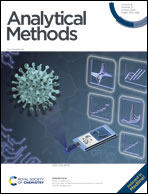Dual-functional porphyrinic zirconium-based metal–organic framework for the fluorescent sensing of histidine enantiomers and Hg2+†
Abstract
A novel fluorescence sensor based on a porphyrinic zirconium-based metal–organic framework, L-cysteine-modified PCN-222 (L-Cys/PCN-222), was developed to selectively recognize histidine enantiomers and sensitively detect Hg2+. The dual-functional sensor was successfully prepared via the solvent-assisted ligand incorporation method and characterized using X-ray diffraction (XRD), scanning electron microscopy (SEM), 1H nuclear magnetic resonance (1H NMR) spectroscopy, Fourier transform infrared (FT-IR) spectroscopy, circular dichroism (CD), X-ray photoelectron spectroscopy (XPS), and nitrogen adsorption–desorption analyses. L-Cys/PCN-222 not only showed a higher quenching response for L-histidine than that for D-histidine with a fast fluorescent response rate of <40 s but also exhibited low detection limits for L- and D-histidine (2.48 μmol L−1 and 3.85 μmol L−1, respectively). Moreover, L-Cys/PCN-222 was employed as a fluorescent and visual sensor for the highly sensitive detection of Hg2+ in the linear range of 10–500 μmol L−1, and the detection limit was calculated to be 2.79 μmol L−1 in surface water. The specific and selective recognition of chiral compounds and metal ions by our probe make it suitable for real field applications.



 Please wait while we load your content...
Please wait while we load your content...